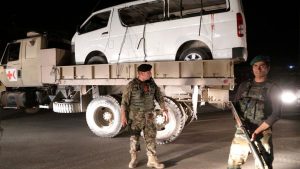In Afghanistan, Trump’s grand strategy begins to fall apart

Afghan security officials remove a damaged vehicle after a suicide bomb attack targeted the Marshal Fahim military academy in Kabul on Saturday. Hedayatullah Amid / EPA
Coincidence, a leading science fiction writer once said, is the word we use when we can’t see the levers and pulleys. In the context of Afghanistan , where the current conflict has decimated lives and hope for 16 years, coincidence is generally a sign of changing realpolitik.
It is no coincidence that US secretary of state Rex Tillerson and Afghan president Ashraf Ghani arrive in the Indian capital on the same day . It wasn’t happenstance that Mr Tillerson made an unannounced visit to Kabul en route to Delhi. And there is definite synchronicity in the dash by America’s chief diplomat to Islamabad immediately before flying off to India.
Mr Tillerson’s swing through South Asia attempts to weave the three capitals together in one tapestry of an Afghan strategy unveiled by president Donald Trump two months ago. The strands are clear. The Afghan government has the security of an open-ended US military commitment but it’s not “a blank cheque”; Pakistan is on notice to help or get out of the way; and India is exhorted to do more, to meet, in Mr Tillerson’s words, “the obligation… to combat the scourge of terrorism”.
This last objective is noteworthy in the context of the past week in Afghanistan . It was particularly bloody, even by the tragic standards set in the country over the years. The toll of attacks by various militant groups on Afghan forces and mosques neared 200 in the span of just a few days. Taliban fighters used stolen or bought US Humvee vehicles as massive bombs to ram into Afghan military bases. Suicide bombers targeted police compounds and government offices. ISIL claimed responsibility for a suicide attack on a Shia mosque in Kabul and there was a separate attack on a Sunni mosque in Ghor province in central Afghanistan.
Some observers say the bloodshed should be seen in a broader context, as a sign that the Trump strategy is working, or at least on the point of working. According to David Sedney, former US deputy assistant secretary of defence for Afghanistan, the violent attacks show the Taliban “lashing out”, enraged that it has not been able to achieve its declared goal of taking and retaining a provincial capital by year-end. And then there is the pressure being piled on Pakistan. Mr Tillerson baldly said this week that “Pakistan needs to take a clear-eyed view of the situation they are confronted with” and urged it to look at Washington’s “very specific requests … to take action to undermine the support the Taliban receives and other terrorist organisations receive”.
If the statements sounded like a threat, that’s because they were. The Trump administration has promised a “conditions-based” relationship with Islamabad, and it has spelt out the terms in simple words. “Take action,” Mr Tillersonboomed in Kabul.
What’s barely heard in all the tough-talking to Pakistan is India’s response. This is because officially, it has taken the form of a studied silence. Unofficially, opposition politicians and retired ambassadors have freely questioned the wisdom of taking up Mr Trump’s grand invitation “to help us more with Afghanistan” and to be a “critical part of America’s South Asia strategy”.
The only unambiguous disavowal of a role as America’s junior partner in Afghanistan has come from India’s envoy in Kabul, Manpreet Vohra. Asked by a journalist if the construction of dams and universities in Afghanistan was enough to guarantee India a “strategic role in the region”, Mr Vohra replied: “What makes you think we are seeking any strategic role in the region?”
So that’s one loose thread of the new US Afghan strategy. What about the others?
Much is being made of the recent US drone strike that killed Omar Khalid Khorasani , a militant pursued by Islamabad for years. Then there is Pakistan’s co-operation in helping recover a Canadian-American couple and their three children, being held hostage by the Taliban for years. That may be encouraging — in fact, Mr Trump suggested it was a sign Islamabad had recovered “respect” for the United States — but it is hardly a robust statement of intent on Afghan policy. Pakistan’s prime minister Shahid Khaqan Abbasi has said he sees a “zero” political or military role for India in Afghanistan, in a very public show of defiance of Mr Trump.
The final piece of the tapestry is the Afghan government. In order to win popular support and deny the Taliban the administrative legitimacy it intermittently acquired in pockets of the country, it needs to improve governance, tackle corruption and penalise inefficiency. As was evident from last week’s Humvee attacks, Mr Ghani’s administration also needs to close security loopholes, identifying militant-sympathisers and sleeper agents within the armed forces.
The US sees these as conditions for its support but there is no guarantee when, or even if, they will be met.
It would be a lucky coincidence if the various strands in America’s new Afghan strategy pulled tight together.
Rashmee Roshan Lall spent a year at the US Mission in Afghanistan from autumn 2011

